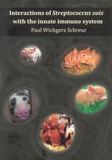Interactions of Streptococcus suis with the innate immune system

Wichgers Schreur, Paul
- Promoter:
- Prof.dr. J.P.M. (Jos) van Putten & prof.dr. M.A. Smits
- Co-promoter:
- Dr. H.E. Smith & dr. J.M.J. Rebel
- Research group:
- Putten
- Date:
- May 15, 2012
- Time:
- 14:30 h
Summary
Streptococcus suis is an important pig pathogen able to cause systemic disease and also able to asymptomatically colonize the upper respiratory tract. In almost all countries, S. suis has become an endemic pathogen and a substantial economic burden due to loss of production and expensive control measurements. Especially the increase in antibiotic resistant S. suis isolates is expected to further complicate the S. suis problem. Besides being a pig pathogen, S. suis is a zoonotic agent. The fast majority of S. suis bacteria isolated from diseased pigs and humans worldwide belong to serotype 2, however, serotype 9 isolates are currently spreading very efficiently in the European and Asian pig population, despite or maybe due to their reduced virulence. The ability to colonize and invade host tissues and to cause disease is expected to partially depend on the reactivity of the host innate immune system. The aim of the study described in this thesis was to better understand the interactions of S. suis with the host innate immune system. The research presented in this thesis led to the identification and characterization of S. suis factors that are able to activate the innate immune system. In addition, we discovered strategies that are used by S. suis to evade host innate immune defense mechanisms. The results show that lipoproteins of S. suis are dominant activators of the human TLR2/6 complex and that lipoproteins significantly contribute to porcine PBMC activation. The lipid-protein structure of lipoproteins was demonstrated to be required for lipoprotein mediated innate immune system activation. We also found that one of the identified lipoproteins, designated TroA, is dominantly present in an innate activating fraction of S. suis and has an important function in manganese acquisition and virulence in mice. Regarding the effector function of the innate immune system, we showed that the resistance of different isolates/serotypes of S. suis to the antimicrobial protein lysozyme is highly variable and that S. suis can adapt to lysozyme pressure by genomic alterations. We discovered that peptidoglycan modification, capsule, and autolysin activity are important factors involved in lysozyme resistance in S. suis. The information obtained in this study may help to improve the development of future vaccines and/or therapeutics to control S. suis infections in the pig industry.